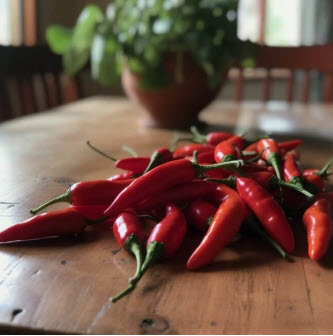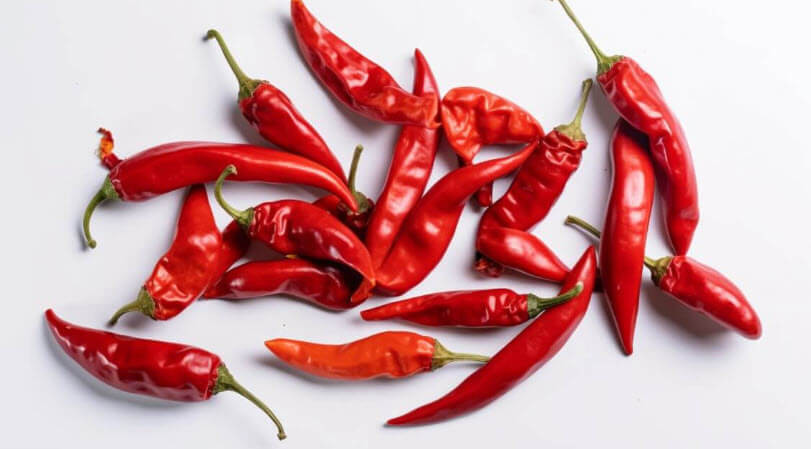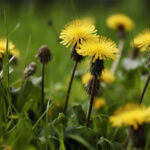Would you prefer to listen to a short podcast discussion about this article? Click on the audio below.
Table of Contents
Chilli peppers, also known as chili peppers or chillies, are a popular and versatile ingredient in many different types of cuisine. Whether you like them mild or extra spicy, growing your own chilli peppers can be a rewarding and cost-effective way to add some heat to your dishes.
However, growing chillies in the UK can be a challenge due to the cooler climate. In this article, we will provide you with a comprehensive guide on how to successfully grow chillies in the UK. From understanding different varieties to harvesting and storing your peppers, we’ve got you covered. Read on to become a chilli pepper growing pro!
Understanding Chillies: Types and Varieties
Spicy food lovers, rejoice! Chillies are a great addition to any dish. These flavorful and fiery fruits are packed with vitamins, minerals, and antioxidants. Not to mention, they add a kick of heat that can take your taste buds to the next level.
Chillies originated in Central and South America, but they have now spread across the world, making their way into many different cuisines. In the UK, chillies are grown both indoors and outdoors, making them a versatile plant to add to your garden.
Popular pepper varieties in the UK
There are many types of chilies available, each with its unique flavour and level of heat. Some of the most popular chilli pepper varieties in the UK include:
– Jalapeño: a medium-sized pepper with a mild to medium heat level
– Habanero: a small, hot pepper with a fruity flavour
– Scotch Bonnet: a small, very hot pepper with a sweet taste
– Thai Chili: a small, very hot pepper commonly used in Thai cuisine
– Cayenne: a long, thin chilli pepper with a hot and spicy flavour
No matter which types you choose, growing chilli peppers in the UK is a fun and rewarding experience.
Preparing the Soil: Optimal Conditions for Growing Your Peppers
Soil requirements for chillies
The first step in growing chilli peppers is to prepare the soil. Chili peppers thrive in well-draining soil with a pH level of around 6 to 7.5. If your soil is too acidic, add lime to raise the pH level. If it’s too alkaline, add sulfur to bring the pH level down.
Choosing the right location for planting
Chillies require plenty of sunlight, so choose a spot in your garden that gets at least six hours of direct sun per day. They also need protection from strong winds, so plant them in a sheltered area or use a windbreak.
Soil preparation techniques
Before planting your chilli peppers, work organic matter, such as compost or well-rotted manure, into the soil to improve its nutrient content and drainage. You can also add a slow-release fertilizer to the soil to provide nutrients throughout the growing season.
Starting Seeds Indoors: Tips and Tricks for Successful Germination
When to start chili pepper seeds indoors
To get a head start on the growing season, start chili pepper seeds indoors 8 to 10 weeks before the last expected frost date in your area. This will give the seedlings time to grow and mature before they are transplanted outside.
Choosing the right container and soil
Choose a container with drainage holes and fill it with sterile seed-starting soil. Place the seeds on top of the soil and cover them with a thin layer of soil. Keep the soil moist but not soggy, and provide plenty of light for the seedlings to grow.
Germination Techniques and best practices
The pepper seeds typically germinate within 7 to 14 days under optimal conditions. To speed up the process, you can place a plastic bag over the container to create a mini greenhouse. Once the seedlings have grown their second set of leaves, you can transplant them into larger containers or into your garden.
Transplanting Seedlings: Do’s and Don’ts
When to transplant chilli pepper seedlings
Wait until the danger of frost has passed before transplanting your seedlings outside. This is usually around late May or early June in the UK, depending on your location.
Transplanting Techniques for successful growth
When transplanting your seedlings, make sure to space them about 18 inches apart to give them room to grow. Dig a hole large enough to accommodate the root ball and gently transfer the seedling into the hole. Fill in the hole with soil and water the plant thoroughly.
Maintaining healthy roots during the transplant process
To prevent damage to the roots, handle the seedlings by their leaves rather than their stems. Water the plants regularly and keep an eye out for pests and diseases. With the right care, your pepper plants will thrive and produce plenty of delicious fruit for you to enjoy.
Caring for Your Plants: Watering, Fertilizing, and Pruning
Chilli peppers are easy to grow, but they require proper care in order to thrive. Here are some tips for watering, fertilizing, and pruning your chilli pepper plants for optimal growth and yield.
Proper watering techniques and frequency
Chillies need regular watering, but they don’t like to be overwatered. Water your plants deeply about once a week, or more often in hot, dry weather. Avoid getting water on the leaves, as this can promote disease.
Choosing the right fertilizer
Choose a fertilizer that is high in potassium, such as a tomato fertilizer. Apply the fertilizer every two weeks during the growing season.
Pruning techniques for optimal growth and yield
Pruning your plants can help promote bushier growth and larger yields. Pinch off the tips of the branches when they reach about six inches in height. This will encourage the plant to branch out and produce more fruit.
Common Pests and Diseases: How to Identify and Treat Them
Even with proper care, chillies can still fall victim to pests and diseases. Here’s how to identify and treat common issues.
Common pests that affect chillies
Aphids, spider mites, and whiteflies are all common pests that can affect chillies. Look for small insects on the leaves and stems of the plant. You can treat these pests with insecticidal soap or neem oil.
Identifying and treating chilli pepper diseases
Chili pepper plants can also be susceptible to diseases such as powdery mildew and verticillium wilt. These diseases can cause yellowing or wilting of the leaves. To prevent these diseases, avoid overcrowding your plants and make sure they have good air circulation. If your plants do become infected, remove infected leaves and treat them with a fungicide.
Preventative measures for pest and disease control
One of the best ways to prevent pest and disease issues is to keep your plants healthy. Make sure they are getting plenty of water and nutrients, and avoid overcrowding your plants. You can also use natural pest control methods, such as planting companion plants like marigolds or using sticky traps to catch insects.
Harvesting and Storing Chili Peppers: When and How to Pick Them
Knowing when to harvest your chili peppers is key to getting the best flavour and heat. Here’s what you need to know about harvesting and storing your chilli peppers.
When chilli peppers are ready to harvest
Chilli peppers can be harvested when they are green or when they have ripened to their final colour (such as red, yellow, or orange). You should wait until the peppers are fully ripe for the best flavour and heat.
Proper harvesting techniques to prevent damage to plants
When harvesting your peppers, be sure to use sharp scissors or pruning shears to cut the stem. Avoid pulling the peppers off the plant, as this can damage the plant and lead to decreased yields.
Storing chillies for long-term use
Fresh chilli peppers can be stored in the refrigerator for up to two weeks. If you have an abundance of peppers, however, you may want to consider drying or freezing them for long-term use. Dried peppers can be ground into spice blends or used to make chilli powder, while frozen peppers can be added to soups, stews, and other dishes.

Cooking with Chili Peppers: Delicious Recipes to Try at Home
Now that you have a bounty of chilli peppers, it’s time to put them to use! Here are some popular chili pepper recipes to try at home.
Popular recipes
Chilli peppers are a key ingredient in many dishes around the world, including the UK. Some popular recipes include chilli con carne, spicy curries, and hot sauces.
Tips for cooking with different chili pepper varieties
Different chilli pepper varieties have different flavour profiles and heat levels. When cooking with chilli peppers, it’s important to choose the right pepper for your dish. For example, jalapenos are milder than habaneros, while serranos have a bright, citrusy flavour.
Start with a small amount of pepper and taste as you go, adding more if needed. And remember, if you can’t handle the heat, remove the seeds and membranes for a milder flavour. With proper care and attention, growing chilli peppers in the UK can be a fun and rewarding experience for any level of gardener.
By following the tips and techniques outlined in this article, you can produce a bountiful harvest of flavorful peppers that will add some heat to your meals all year round. Don’t be afraid to experiment with different varieties and recipes – chilli peppers are a versatile ingredient that can elevate any dish. Happy growing!
FAQ
1. Can I grow chilli peppers in the UK, even with a cooler climate?
Yes, you can grow them in the UK. However, you will need to take certain factors into consideration, such as soil preparation, location, and varieties that are more tolerant to cooler temperatures.
2. What is the best way to germinate the seeds?
Starting the seeds indoors is the most effective way to ensure successful germination. Sow seeds in a warm and moist environment, such as a propagator or covered seed tray, and ensure they receive plenty of light.
3. How often should I water my plants?
Chilli pepper plants require consistent moisture, but not overwatering. Watering once or twice a week, or when the top inch of soil is dry to the touch, is usually sufficient.
4. How do I prevent pests and diseases from affecting my plants?
Regular inspection and removal of any infected or damaged leaves or stems are important to prevent the spread of pests and diseases. Additionally, proper soil preparation, watering, and fertilization can help your plants grow strong and resilient to these issues.
If you are keen on organic gardening, check out The Soil Association website
If you need any further information or assistance with this article, don’t hesitate to Contact Us




















